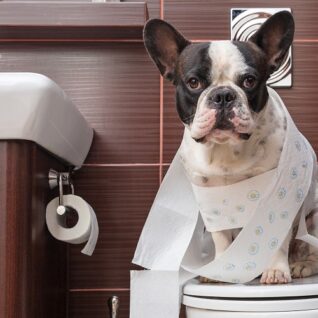The article below pertaining to 4 Reasons Why Dog Poop Cleanup is Important is amazingly captivating. Don't miss it.

When it pertains to disposing of waste, specifically animal waste, many people usually resort to the convenient choice of flushing it down the bathroom. Nevertheless, this apparently easy solution can have major repercussions for the atmosphere and public health. In this short article, we'll explore why flushing pet waste down the bathroom is a negative idea and provide alternate approaches for proper disposal.
Introduction
Appropriate garbage disposal is essential for maintaining ecological sustainability and public health. While it may seem safe to flush animal waste down the commode, it can cause different issues, both for the setting and human well-being.
Threats of flushing animal waste
Environmental influence
Flushing pet waste presents damaging microorganisms and virus right into waterways, which can adversely influence marine ecological communities. These virus can infect water resources and injury aquatic life, interrupting delicate ecosystems.
Public health worries
Animal waste includes unsafe germs such as E. coli and Salmonella, which can posture severe health and wellness risks to humans. Purging pet waste down the bathroom can contaminate water products, causing the spread of illness and infections.
Alternatives to flushing
Rather than purging animal waste down the toilet, there are several different disposal techniques that are much more environmentally friendly and hygienic.
Composting
Composting pet waste is an eco-friendly means to throw away it. By composting, raw material is broken down into nutrient-rich soil, which can be made use of to fertilize yards and plants.
Garbage dump disposal
Getting rid of pet waste in a garbage dump is an additional alternative. While not as environmentally friendly as composting, it is a much safer option to flushing, as it protects against the contamination website of water sources.
Pet garbage disposal systems
There are specific family pet waste disposal systems available that securely and hygienically throw away animal waste. These systems commonly use enzymes to break down waste and get rid of smells.
Actions to proper pet waste disposal
To guarantee proper disposal of pet waste, adhere to these actions:
Scooping and nabbing waste
Consistently scoop and bag animal waste using biodegradable bags. This avoids waste from polluting the atmosphere.
Utilizing assigned waste bins
Dispose of bagged animal waste in designated waste bins, such as compost containers or land fill containers. Stay clear of flushing it down the commode in any way expenses.
Cleaning up litter boxes and pet dog locations on a regular basis
On a regular basis clean litter boxes and animal areas to prevent the accumulation of waste and bacteria. Usage pet-safe cleaning items to maintain health.
Benefits of correct disposal techniques
Adopting correct disposal methods for pet waste provides numerous benefits:
Minimized environmental pollution
Proper disposal techniques lower the risk of environmental pollution, shielding waterways and environments from contamination
Minimized threat of water contamination.
By avoiding flushing animal waste down the bathroom, the threat of water contamination is significantly minimized, guarding public health.
Boosted sanitation and hygiene
Proper disposal techniques advertise much better sanitation and health, producing a more secure environment for both humans and animals.
Final thought
Finally, purging animal waste down the bathroom is unsafe to the setting and public health. By embracing alternate disposal methods and adhering to correct waste administration practices, we can decrease the unfavorable impact of pet waste and contribute to a cleaner, much healthier world.
What To Do With Dog Poo – The Do's And Don'ts Of Disposing Of Faeces
Dog poo bins
Some councils provide dedicated dog waste bins in popular dog-walking areas that can take dog poo that has been bagged but you can legally dispose of dog waste in any public litter bin, as long as it is securely bagged. This also applies to your wheelie bin at home.
Do not flush
Water companies do not recommend flushing dog faeces down the toilet because certain parasites can survive the water processing treatment and are potentially harmful to humans. You should also never consider flushing dog poo that has been bagged down the toilet as the bags will not break down and instead create severe blockages in the sewage system.
In the woods
The Forestry Commission promotes a ‘stick and flick’ method for dealing with waste in the woods. This means finding a stick and using it to flick any poo from off the path so that it is out of the way of other walkers. You could also bury it as long as it is not in an area where there might be livestock.
Livestock
Parasites found in dog poo can be transmitted to livestock if they inadvertently eat infected faeces that has been left on grazing land. This could result in the death of sheep or abortion in cattle so you should always make sure you pick up your dog’s waste in fields where livestock could be present.

On a regular basis clean litter boxes and animal areas to prevent the accumulation of waste and bacteria. Usage pet-safe cleaning items to maintain health.
Benefits of correct disposal techniques
Adopting correct disposal methods for pet waste provides numerous benefits:
Minimized environmental pollution
Proper disposal techniques lower the risk of environmental pollution, shielding waterways and environments from contamination
Minimized threat of water contamination.
By avoiding flushing animal waste down the bathroom, the threat of water contamination is significantly minimized, guarding public health.
Boosted sanitation and hygiene
Proper disposal techniques advertise much better sanitation and health, producing a more secure environment for both humans and animals.
Final thought
Finally, purging animal waste down the bathroom is unsafe to the setting and public health. By embracing alternate disposal methods and adhering to correct waste administration practices, we can decrease the unfavorable impact of pet waste and contribute to a cleaner, much healthier world.
What To Do With Dog Poo – The Do's And Don'ts Of Disposing Of Faeces
Dog poo bins
Some councils provide dedicated dog waste bins in popular dog-walking areas that can take dog poo that has been bagged but you can legally dispose of dog waste in any public litter bin, as long as it is securely bagged. This also applies to your wheelie bin at home.
Do not flush
Water companies do not recommend flushing dog faeces down the toilet because certain parasites can survive the water processing treatment and are potentially harmful to humans. You should also never consider flushing dog poo that has been bagged down the toilet as the bags will not break down and instead create severe blockages in the sewage system.
In the woods
The Forestry Commission promotes a ‘stick and flick’ method for dealing with waste in the woods. This means finding a stick and using it to flick any poo from off the path so that it is out of the way of other walkers. You could also bury it as long as it is not in an area where there might be livestock.
Livestock
Parasites found in dog poo can be transmitted to livestock if they inadvertently eat infected faeces that has been left on grazing land. This could result in the death of sheep or abortion in cattle so you should always make sure you pick up your dog’s waste in fields where livestock could be present.

As an avid reader on , I figured sharing that excerpt was a great idea. Are you aware of someone else who is curious about the topic? Be sure share it. We truly appreciate reading our article about .
Call